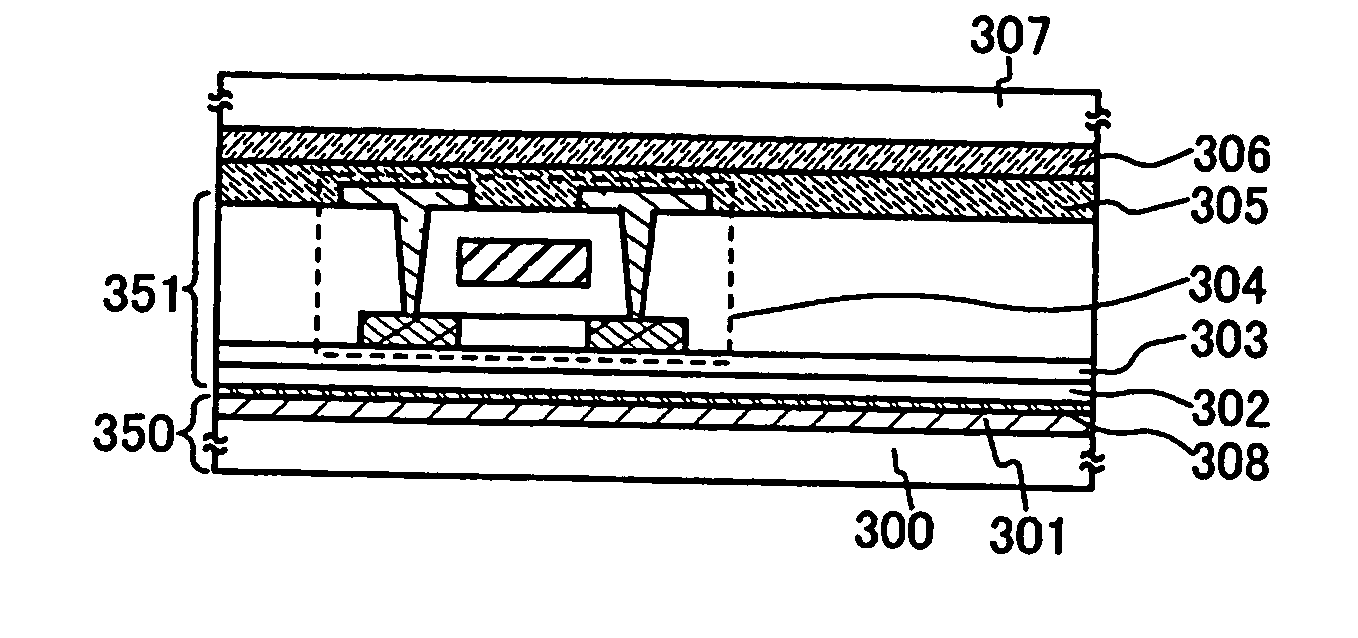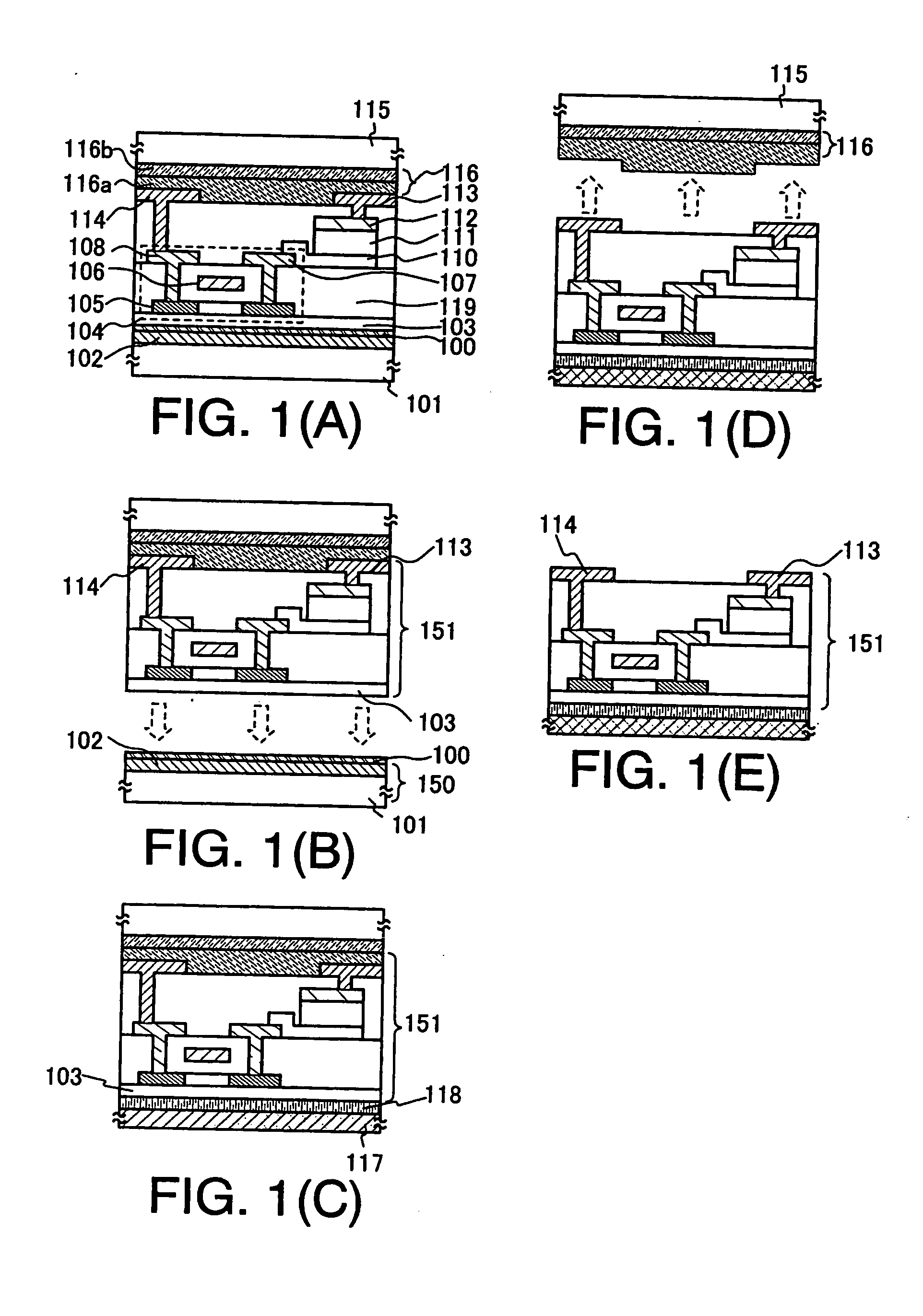Semiconductor device and method of manufacturing thereof
- Summary
- Abstract
- Description
- Claims
- Application Information
AI Technical Summary
Benefits of technology
Problems solved by technology
Method used
Image
Examples
embodiment mode 1
[0054] A method for manufacturing a semiconductor device including a semiconductor element having an amorphous silicon film as an active region and a semiconductor element having a polysilicon film as an active region over a plastic substrate is described in this embodiment mode with reference to FIGS. 1(A) TO 1(E).
[0055] First, a metal film 102 is formed over a substrate 101. A single layer made of one element of W, Ti, Ta, Mo, Cr, Nd, Fe, Ni, Co, Zr, Zn, Ru, Rh, Pd, Os, and Ir or an alloy material or a compound material containing the element as its main component, a laminate thereof, a single layer of nitride thereof, or a laminate thereof may be used as the metal film 102. A film thickness of the metal film 102 is set from 10 nm to 200 nm, preferably, from 50 nm to 75 nm.
[0056] Next, an insulating film 103 is formed over the metal film 102. At this time, a metal oxide film 100 in an amorphous state is formed between the metal film 102 and the insulating film 103 to have a thic...
embodiment mode 2
[0083] A method for manufacturing a semiconductor device over a plastic substrate, typically, a flexible plastic substrate in a different way from that in Embodiment Mode 1 is described in this embodiment mode with reference to FIGS. 2(A) to 2(E).
[0084] As in Embodiment Mode 1, a metal film 202, an insulating film 203, and a TFT 204 are sequentially formed over a first substrate 201 as shown in FIG. 2(A). At this time, a metal oxide film 200 in an amorphous state is formed between the metal film 202 and the insulating film 203 to have a thickness of approximately from 2 nm to 5 nm, as in Embodiment Mode 1.
[0085] Note that the TFT 204 includes a polysilicon film having a source region, a drain region, and a channel formation region, a gate insulating film covering the polysilicon film, a gate electrode formed over the channel formation region of the polysilicon film, and a source electrode and a drain electrode which are connected to the source region and the drain region through a...
embodiment
EMBODIMENT 1
[0096] An example of manufacturing an optical sensor including a TFT having a polysilicon film as an active region and a diode having an amorphous silicon film as an active region by using the steps of Embodiment Mode 2 is described in this embodiment with reference to FIGS. 3(A) to 3(D). Note that the optical sensor of this embodiment is a non-storage type optical sensor.
[0097] A TFT 304 is formed over a glass substrate (first substrate 300) as shown in FIG. 3(A). A metal film 301, here, a tungsten film (film thickness: 80 nm) is formed over the glass substrate by a sputtering method, and further, an insulating film 302, here, a silicon oxide film (film thickness: 160 nm) is laminated without being exposed to atmospheric air by a sputtering method. At this time, a tungsten oxide film 308 in an amorphous state is formed between the tungsten film 301 and the silicon oxide film 301 to have a thickness of approximately from 2 nm to 5 nm. Since the tungsten film and the si...
PUM
 Login to View More
Login to View More Abstract
Description
Claims
Application Information
 Login to View More
Login to View More - R&D
- Intellectual Property
- Life Sciences
- Materials
- Tech Scout
- Unparalleled Data Quality
- Higher Quality Content
- 60% Fewer Hallucinations
Browse by: Latest US Patents, China's latest patents, Technical Efficacy Thesaurus, Application Domain, Technology Topic, Popular Technical Reports.
© 2025 PatSnap. All rights reserved.Legal|Privacy policy|Modern Slavery Act Transparency Statement|Sitemap|About US| Contact US: help@patsnap.com



